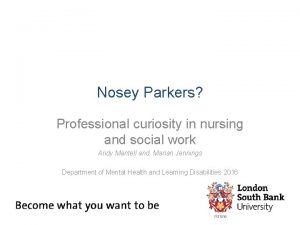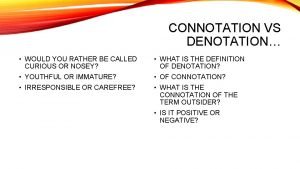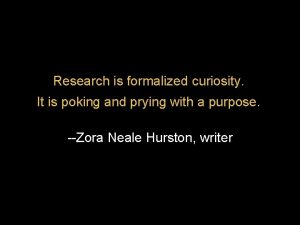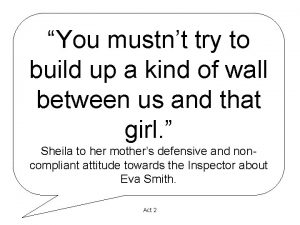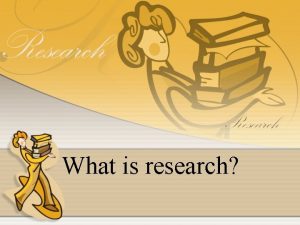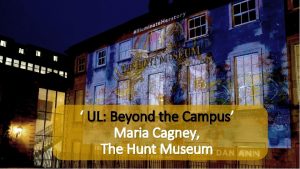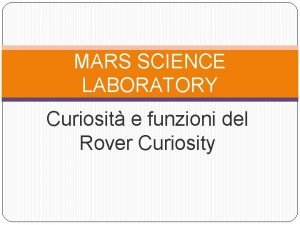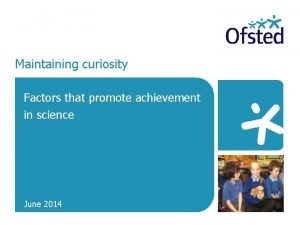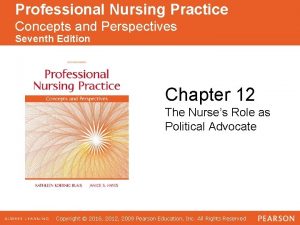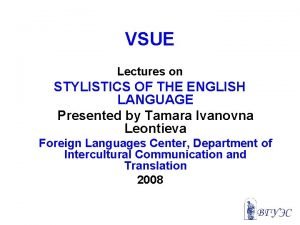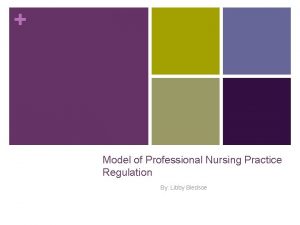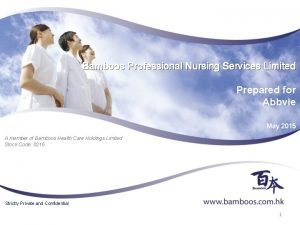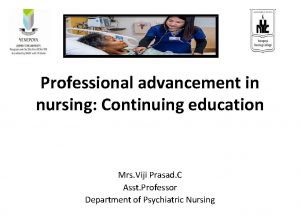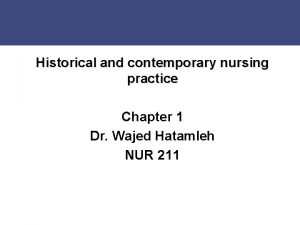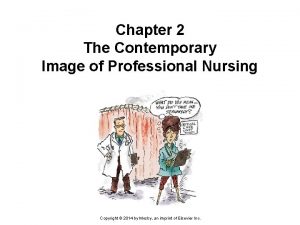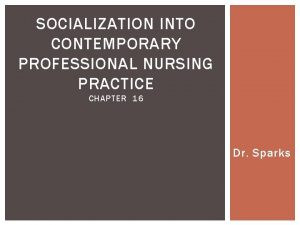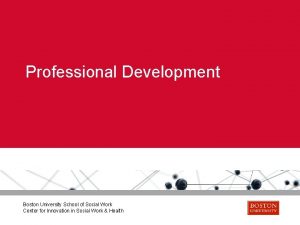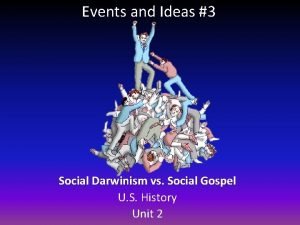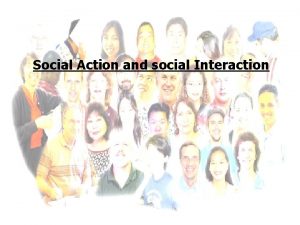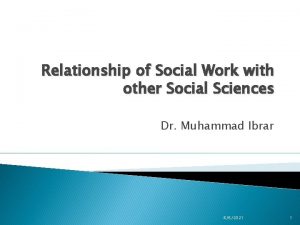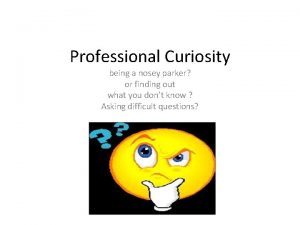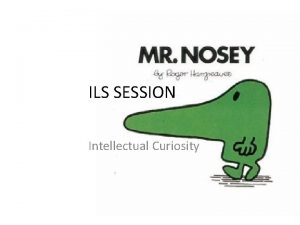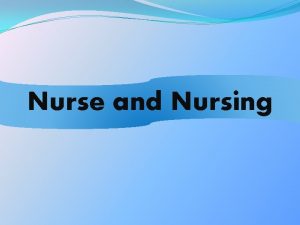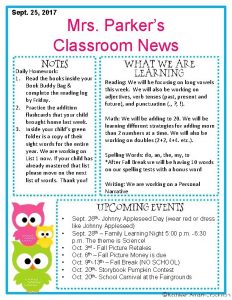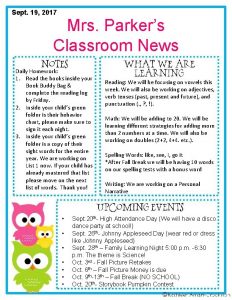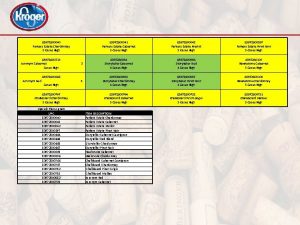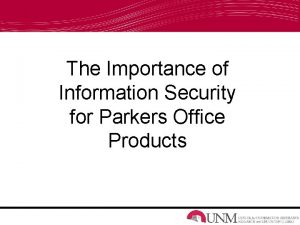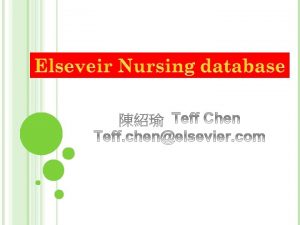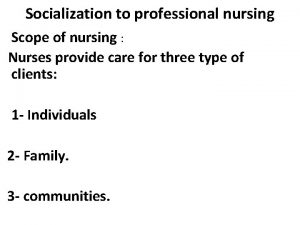Nosey Parkers Professional curiosity in nursing and social



































- Slides: 35

Nosey Parkers? Professional curiosity in nursing and social work Andy Mantell and Marian Jennings Department of Mental Health and Learning Disabilities 2016

Curiosity - an essential attribute • • • Curiosity and a desire to enhance and develop nursing knowledge are vital in nursing practice. (Easton 2010) There is a need for health care professionals to make routine enquiries -'the need for professional curiosity is paramount'. (Kirtley 2013: 10) Qualified, experienced, advanced SW should use critical thinking augmented by creativity and curiosity (BASW 2015 online).

The impact of a lack of professional curiosity (PC) • Lack of professional curiosity repeatedly cited in enquires into the abuse of children. • Disguised compliance -“Some families are very good at providing professionals with what they need to hear” (Woolmore, interviewed by Naqvi 2013: 15) • Woolmore argues that in order to see “…beyond the barriers put up by families says it is vital social workers retain their ‘professional curiosity’”.

Purpose • Research question: o What is the significance of professional curiosity to contemporary nursing and social work practice? • Aims: o Identify the knowledge base that has been produced by nursing and social work. o Identify themes with significance for trans-disciplinary practice. • Objective: o To highlight the contribution that professional curiosity make to practice in both professions.

Methodology: Scoping Study (Arkesy and O’Malley 2005) Determine research question Mantell and Jennings 2016 Identify items Select items Charting the data Summary

Identifying items • To identify the literature produced in social work the following databases were searched from 2005 to 2015 : – Medline, – Psychinfo, – Soc Index, Cinahl, – ASUS – SCOPUS • The search term used were ‘Professional curiosity”, “Professional curiosity” and “social work” and “curiosity” and “social work”. • This was repeated for nursing, with ‘nurs*’ substituted for ‘social work’.

Selecting items • The social work search produced 29 results of which 20 were not about social work, 4 not on PC. One was a book review. – 4 were accepted. • The nursing search produced 27 of which 22 did not meet the criteria and 1 was prior to 2005. – 4 were accepted. • The iterative search produced 9 items results, none of which met the criteria.

Findings – social work (Mantell and Jennings 2016) Name Milner V. White J. Voshel E. Shenaar-Golan V. & Gutman C Year 2005 2007 2012 2013 Country of origin New Zealand Canada USA Israel Source Social Work Review Canadian Journal of Counselling Reflections: Narratives of Professional Helping Social work with Groups Title Mapping the new frontier of Foodbank social work Working in the Midst of Ideological and Cultural Differences Reflections of a Curiosity and Field Director the Cat: Teaching Strategies That Foster Curiosity Practice area Models ADP Reflective Education (group work) Knowledge type Expert opinion Relevance Relevant Low relevance Very relevant

Findings – nursing (Mantell and Jennings 2016) Name Kedge, S and Appleby, B De. Silets, L. D. , Eason, T. & Dickerson, P. S Year 2009 2010 Country of origin UK UK USA Source British Journal of Nursing Journal of Continuing Education in Nursing Creative Nursing Title Promoting a culture of curiosity within nursing practice Promoting curiosity through the enhancement of competence Continuing nursing education: Enhancing professional development Lifelong Learning: Fostering a Culture of Curiosity Practice area Education Expert opinion Knowledge type Expert Opinion

What is professional curiosity? • Immersing oneself Explore Inquisitiveness • • “What makes me question, know, act, ask again, recognize” (Freire 1998: 80) Engage “A state of arousal brought about by complex stimuli that leads to exploratory behavior” Shenaar – Golan and Gutman 2013: , after Berlyn 1960 Learning “A desire to know, to see or to experience that motivates exploratory behavior directed towards the acquisition of new information” (Litman 2005: 793) Mantell and Jennings 2016 Precursor to reflection

Areas where curiosity plays a role üHelps us engage with other cultures ü Helps clients explore their world ü Enhances reflection ü Enhances accountability ü Professional development

Whose story do we hear? ØThe client? ØThe carer? ØOther professionals? ØOur employers? ØOur own? Impact of stereotyping and professional prejudice? Refection - how do you know, what you don’t know? How do we uncover the story?

Lessons from child protection: Uncovering the ‘real’ story. • Whose story do we hear? Ø The client? Ø The carer? Ø Other professionals? Ø Our employers? Ø Our own? • Impact of stereotyping and professional prejudice? • Refection - how do you know, what you don’t know? • How do we uncover the story?

Factors that inhibit us hearing and responding to the story • Tactical lack of curiosity – to avoid ‘nosiness’ • Assumptions • Uncertainty • Lack of time • Lack of inclination – going through the motions • Anxiety • Culture – don’t go looking for work • Lack of insight into practice • Lack of creativity in looking for solutions

Mind Expanding: The importance of nurturing your own curiosity • In social work and nursing in the UK, practitioners need to provide evidence of continued development to maintain their registration. • Competence impacts on self-esteem, self respect, professional status and meaningful work (Desilets and Dickerson 2010) • Professional curiosity is a driver in acquiring knowledge and updating skills (Eason 2010). • It is a life long process (Eason 2010).

Enquiring minds: The importance of curiosity for educators • The educator’s role is to: “… keep alive the sacred spark of wonder and to fan the flame that already glows” (Dewey, 1938: 34). • “…good professional practice is driven by knowledge of the latest theory and research” (Munro 2011: 19) • Effective pedagogy must incorporate elements that promote interest and curiosity (Shenaar –Golan and Gutman 2013).

Nurturing curiosity through education • Zone of curiosity (Day 1982) • Make training meaningful: ü Clear linkage of the impact of curiosity in the clinical environment (Kedge and Appleby 2010) with people with TBI. ü Practice dilemmas and role play. • Curiosity needs to be encouraged across modules as an essential aspect of reflection. • Develop understanding of: ü Issues to be alert to, such as CSE, potential signs etc ü How to respond (channeling their curiosity appropriately) ü Legal framework, for example, young peoples competence.

Professional curiosity: The importance of curiosity for employers Systems • Continuous Professional Development - Professional development underpins the role of social workers and nurses (Desilets and Dickerson 2010). • Reduced hierarchy can reduce risk of organisational abuse. • Inflexible, bureaucratic systems – hit the target, but miss the point. • Legal implications – FGM, CSE

Professional curiosity: The importance of curiosity for employers Culture • Open cultures encourage challenge to existing practices and development of innovative practices. • A culture which fosters curiosity is critical to sustaining a dynamic workforce (Eason). And • A dynamic work environment promotes professional curiosity.

The employer’s role in nurturing curiosity • Links to pay and promotion • Study leave • Secondments • Staffing levels • Time • Value and cultivate professional opinion v routine • Fund training • Develop ‘champions’ in specialist areas. • Use specialists consultants

Discussion • Aim 1: Identify the knowledge base that has been produced by nursing and social work. ü The nursing literature has a clear focus on education and the continued development of competence, whereas the social work knowledge base is more disparate in focus and origin.

Discussion • Aim 2: Identify themes with significance for trans-disciplinary practice. ü Serious Case Reviews identified the following inhibitors to PC: Ø Making assumptions Ø Fitting information to early hypothesis Ø Lack of understanding about specific issue Ø Lack of knowledge of legislation Ø Pressures of work, Ø Stress Ø Reluctant clients

Discussion • Objective: To highlight the contribution that professional curiosity make to practice in both professions. ü The knowledge base for professional curiosity in social work and nursing is still in its infancy. ü What is meant by professional curiosity as opposed to ‘common sense’ curiosity still requires clarification.

Discussion Limitations i. Hearing practitioner’s voices on practice. ii. Social work and nursing articles in non-discipline specific journals were not included. iii. Earlier articles not included. iv. Literature by other professionals not included. v. Nursing articles focused on the impact of professional curiosity in the classroom as opposed to it’s impact in practice.

Recommendations – the need to define terms Curiosity by professionals encompasses: Ø Knowledge acquisition – includes exploring situations, evidenced based practice, life long learning etc. Ø Reflective praxis – exploring and developing our practice and the governing factors that may limit it, for examples systems and culture of organisations. Ø Purposeful Information gathering from all sources in connection with an intervention and towards specific goals.

Recommendations – the need to define terms Professional curiosity describes a method of practicing: Ø a strengths based and goal focused approach to engaging with individuals. A partnership of exploration that can enable the client to learn as much about themselves as the practitioner does (Buechler 2004).

Recommendations: curiosity check list (after Broadhurst et al. 2010) Practitioners Employers Educators Am I remaining curious and inquisitive about what I am seeing and assessing? Is the “front-door” organised to ensure optimum conditions for the receiving and recording of information? Is a culture of openness promoted in relation to practitioners’ anxieties and uncertainties? Am I open to new information? Am I able to prioritise the needs of people with TBI over performance targets where necessary? Are students set practice orientated examples & role plays which stretch them, but are still achievable? Would I be prepared to change my mind about this case? Do assessment forms encourage the recording of gaps in understanding? Are students taught how to critically scrutinise evidence? Is there sufficient quality and quantity of evidence for judgment? Does the culture allow for professionals to challenge each others findings? Are students encouraged to challenge their biases? Am I exploring process as well as content? How are habitual practices avoided? Are students taught how to observe and listen? Am I able to challenge this person? Can I recognise when staff are Are students taught how to under stress? clearly pass on information?

Conclusion Curiosity is the very basis of education, and if you tell me that curiosity killed the cat, I say only that the cat died nobly. (Arnold Edinborough cited in Shenaar. Golan 2013) • Curiosity has a central and overlapping role to play in our training, professional practice and individual development. • So what questions are you going to ask?

Thank you for listening Any questions? Contact Dr Andy Mantell at: mantella@lsbu. ac. uk

References • • • Arksey, H & O'Malley L (2005): Scoping studies: towards a methodological framework, International Journal of Social Research Methodology, 8: 1, 1932 Arnone, M (2003) Using instructional design to strategies to foster curiosity. Available from: http: //www. ericdigests. org/2004 -3/foster. html (accessed 29/4/16) BASW (2015) Professionals Capabilities Framework. Available from: https: //www. basw. co. uk/pcf/capabilities/? level=10 (accessed 29/4/16) Bedford, A (2015) Serious Case Review into Child Sexual Exploitation in Oxfordshire: from the experiences of Children A, B, C, D, E, and F. Oxfordshire Safeguarding Children Board. Available from: http: //www. oscb. org. uk/wp-content/uploads/SCR-into-CSE-in-Oxfordshire. FINAL-FOR-WEBSITE. pdf (accessed 26/4/16) Berlyn, D (1960) Conflict, arousal and curiosity. New York: Mc. Graw-Hill.

References • • • Broadhurst, K, White, S, Fish, S, Munro, E, Fletcher, K and Lincoln, H. (2010 Ten pitfalls and how to avoid them: What research tells us. NSPCC, available from: https: //www. nspcc. org. uk/globalassets/documents/research-reports/10 -pitfalls-initialassessments-report. pdf (accessed 10/5/16). Buechler, S (2004) Clinical Values: Emotions that Guide Psychoanalytic Treatment. Abingdon, Oxon: Routledge Cooper, J (2011) The need for more critically reflective social work. Community Care, Available from: http: //www. communitycare. co. uk/2011/04/08/the-need-for-more-critically-reflective-socialwork/ (accesed 28/4/16) Day H (1982) Curiosity and the interested explorer. NSPI Journal 4, 19 -22 Department of Health and Social Services Inspectorate (1996) A Hidden Disability: The report of the SSI Traumatic Brain Injury Rehabilitation Project. London: HMSO. Department of Health (2005) Kerr/Haslam Inquiry: Full Report. London: TSO (The Stationery Office). Dewey, (1938) How we think. Boston MA: Houghton Eason, T. (2010)Lifelong Learning: Fostering a Culture of Curiosity Creative Nursing 16(4): 1559 Griffin, A. (2015) Blue and black or white and gold, how the dress colour you see says a lot about you. The Independent 15 th February 2015[online]. Available from http. //. www. independent. co. uk › News › Science [last accessed 19 th August 2016]

References • • • Freire, P (1998) Pedagogy is freedom: Ethics, democracy and civic courage. Lanham MD. Rowman and Littlefield. Harbeck Voshel E (2012) Reflections of a field director: An opportunity to look into the past and see the future. Reflections 18 (2) 24 -31. Kedge, S and Appleby, B. (2010) Promoting a culture of curiosity within nursing practice. Britih Journal of Nursing 2009, Vol 18, No 10 Kedge, S and Appleby, B. (2009) Promoting curiosity through the enhancement of competence British Journal of Nursing 2010, Vol 19, No 9 Kirtley, P (2013) If you shine a light you will probably find it. Report of a grass roots survey of health professionals with regard to their experiences of dealing with child sexual exploitation. NWG Network. Available from nwgnetwork. org (Accessed 9/8/16). Harrington, M (2016) On the road. Shutterbug (May Edition). Bhardwa, S (2015) A Local Responsibility. Independent Nurse 16 th February 2015. Available from: https: /www. independentnurse. co. uk/news/fgm-a-local-responsibility/73859/( assessed 18 th May 2016) Izard C (1977) Human Emotions. New York: Plenum Press. Kashdan, T Social anxiety spectrum and diminished positive experiences: Theoretical synthesis and meta-analysis. Clinical Psychology Review 27, 348 -365.

References • • Litman, J (2005) Curiosity and the pleasures of learning: Wanting and liking new information. Cognitive Emotion 19(6) 793 -814 Loewenstein’s G (1994) The psychology of curiosity. A review and re-interpretation. Psychological Bulletin 116, 75 -98 Mantell, A (2010) Traumatic Brain Injury and Potential Safeguarding Concerns. Journal of Adult Protection, 12(4) 31 -42. Mantell, A and Jennings M (2016) Professional Curiosity and Traumatic Brain Injury. ICSW, Eighth International Conference on Social Work in Health and Mental Health, National University of Singapore 19 -23/6/16. Milner, V (2005) Mapping the new frontier of foodbank social work. Social Work Review. Munro (2011)The Munro Review of Child Protection: Interim Report. Available from: https: //www. gov. uk/government/uploads/system/uploads/attachment_data/file/2069 93/DFE-00010 -2011. pdf (accessed 5/5/16) Naqvi, S (2013) Thinking the unthinkable. Professional Social Work, May, 14 -14. Available from http: //cdn. basw. co. uk/upload/basw_30935 -9. pdf (accessed 11/5/16) NMC (2015) https: //www. nmc. org. uk/. . . /nurses-and-midwives-will-have-to-reportcases-of-fgm/( assessed 18 th May 2016)

References • • • Oshikanlu, R (2014) Re-Kindle your Curiosity. Nursing Times 9/5/14, Available from: www. nursingtimes. net/rekindle-your-curiosity ( assessed 18/5/16) Prilleltensky, I. , Rossiter, A. , & Walsh-Bowers, R. (1996). Preventing harm and promoting ethical discourse in the helping professions. Ethics and Behaviour 4, 287 -306. Shenaar-Golan V and Gutman C (2013) Curiosity and the cat: Teaching strategies that foster curiosity. Social work with groups 36(4) 349 -359 Tate R, Broe G & Lulham J (1989) Impairment after severe blunt head injury: the results from a consecutive series of 100 patiewnts. Acta Neurologica Scandinavica 79 (2) 97– 100. Vygotsky, L (1978). Mind in society: The development of higher psychological processes. Cambridge, MA: Harvard University Press White, J (2007) Working in the Midst of Ideological and Cultural Differences: Critically Reflecting on Youth Suicide Prevention in Indigenous Communities. Canadian Journal of Counselling 41(4), 213 -227. www. independent. co. uk

Acknowledgements • We would like to thank Jo Delree for her support
 Professional curiosity
Professional curiosity Nosey connotation
Nosey connotation Professional curiosity munro
Professional curiosity munro Curiosity and the copycat
Curiosity and the copycat A piece of gross impertinence analysis
A piece of gross impertinence analysis Intellectual curiosity definition
Intellectual curiosity definition Studious inquiry
Studious inquiry Natural curiosity
Natural curiosity Curiosity
Curiosity Robot curiosity funzioni
Robot curiosity funzioni Maintaining curiosity
Maintaining curiosity 5 levels of prevention leavell and clark
5 levels of prevention leavell and clark Political astuteness in nursing
Political astuteness in nursing Apa itu social thinking
Apa itu social thinking Social thinking social influence social relations
Social thinking social influence social relations Le phenix de la famille meaning
Le phenix de la famille meaning Legal ethical and professional aspects of security
Legal ethical and professional aspects of security Jargonisms
Jargonisms Model of professional nursing practice regulation
Model of professional nursing practice regulation Languagr
Languagr Nursing accountability examples
Nursing accountability examples Professional advancement in nursing
Professional advancement in nursing Factors influencing contemporary nursing practice
Factors influencing contemporary nursing practice Contemporary nursing image
Contemporary nursing image Socialization into professional nursing ati
Socialization into professional nursing ati Nurses touch socialization into professional nursing
Nurses touch socialization into professional nursing Team nursing and modular nursing
Team nursing and modular nursing Boston university social work
Boston university social work Social darwinism vs social gospel answer key
Social darwinism vs social gospel answer key Obsessive compulsive disorder nursing diagnosis
Obsessive compulsive disorder nursing diagnosis Nursing diagnosis on cataract
Nursing diagnosis on cataract Nursing interventions for neonatal abstinence syndrome
Nursing interventions for neonatal abstinence syndrome Nursing process in psychiatric nursing
Nursing process in psychiatric nursing Social action vs social interaction
Social action vs social interaction Social work and other social sciences
Social work and other social sciences Social thinking and social influence
Social thinking and social influence
